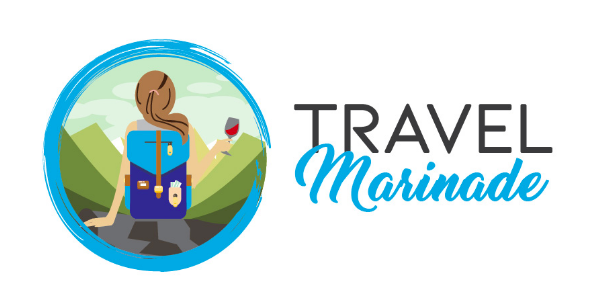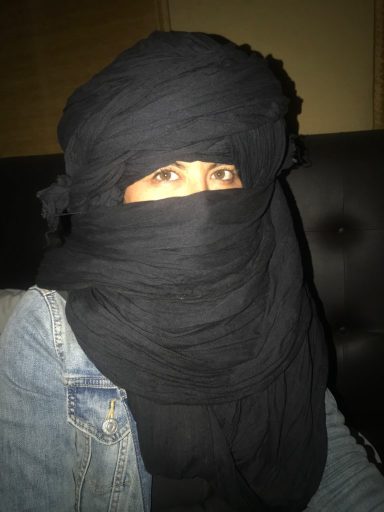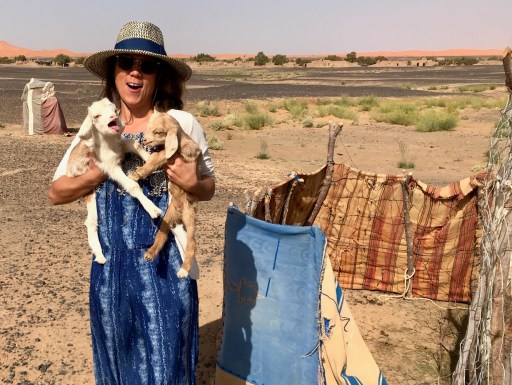I’m a little nervous about my first winter trek not knowing how technical this hike is going to be, but I feel overwhelmed by the number of guides trying to sell me tours to the Sahara Desert that I need to get away from it all.
(I use ‘all’ in code because I received two pieces of important news less than a week ago and one of those is about to change my life.)
Now I am in Morocco, a place I know nothing about other than mint tea, mosaic tile, and that Penny Lane from the movie, Almost Famous, said she was going to escape there for a year.
Back to the trek, right… my ADD is kicking in again.
DAY ONE: Marrakech to Imlil
13,880 steps, 5.8 miles, 93 floors

I start my morning with an 8:30 am pickup at the Rooftop Hostel. I’ve been staying at this hostel for the last week that I got to know the staff quite well. Rabir, usually dressed in a warm neutral colored djellaba, speaks broken English, but for some reason likes to always say “Marhba!” when he sees me which means, “Welcome!” I always respond just as enthusiastically with, “Choukran!” which means “Thank you!” and that was how we bonded.
My driver picks me up and he helps me carry the sleeping bag that was lent to me by another Moroccan who owns, Atlas Extreme, an outdoor equipment rental shop in Imlil. I’m packed a little light and insist on carrying my own backpack.
It’s a long drive to pick up the other girl who is supposed to join me on this trip. Well, I’m actually joining her. The trekking company, Trek in Morocco, I booked through said the girl signed up for a private tour but didn’t want to trek alone so apparently I got a decent price – until I found the same trek for about $60 cheaper on Tour Radar. Ugh, I hate negotiating tour rates. I always feel like I’m getting ripped off.
Back to the girl.

The distance to the girl’s riad felt far outside the medina. We park just outside of an alleyway – very common for Marrakech – the city is built to confuse you and doesn’t allow any parking in many areas of the Jemaa el-Fnaa (marketplace and square). My driver is gone for around 15 minutes, and I sit patiently in the backseat keeping myself busy on social media. He comes back and tells me she is finishing breakfast, but we’ll drive around to a closer pickup point. It’s nearly 9:30 am at this point that I have a feeling this girl is the type to habitually run late.
We drive around, and he leaves again for another 20 minutes until I finally see them. She’s a light brown skinned, petite girl with a dark brown pixie cut and one subtle highlight into her fringe. I hear her from behind asking the driver, “Is anyone else in the car?” and he tells her I’m there. Then she asks about the group of British guys that were also supposed to come until she learns that it’s just the two of us.
Nina (pseudo name) introduces herself. She’s Pakistani living in UAE and working in advertising. I find the advertising business very sexy and started to ask her lots of questions.
I told her a little about myself. It’s my first time to Morocco, yadda, yadda.
About an hour and a half later, we drive up the mountain to our first checkpoint. There was an “incident” that happened a couple weeks ago involving two Scandinavian girls. I try to ignore it as the guards review our passports and driver’s paperwork.
Not long after we finally reach our destination to a windy hill in a small village. I read on the sign, “Riad Oussagou.” More men help us with our bags, Nina’s being oversized. We are both shown our rooms, and I am surprised to find that I had my own. This is the first bit of privacy I’ll have in a week.
The room is very comfortable and cozy with extra heavy blankets, a hanging djellaba, and *cheering * a bathtub. Woot! I’m luxury living now and can’t wait to use that later.
It’s only around 10:30 am by this point, so we have enough time to take a small break before we go on a short acclimatization hike. The trails are well-defined, and it’s actually quite warm once we hit the sun.

A few hours later, we make it to a viewpoint where our cook, Hamid, prepares a nice lunch for us – pasta salad with sardines and kefta served in a tagine.


We head back down the hill after lunch and before sunset, so I use the free time to take a nap before dinner. It’s actually quite cold once the sun hid behind the mountains. I lost my down jacket in the airport on my way to Morocco, so I layer myself with all that I have to work with, and that’s a long sleeve top, a yoga jacket, and my jean jacket. It’s still not warm enough, so I grab the brown djellaba; albeit I don’t think brown is my color. It was money though. Money in the sense I felt like Riad Oussagou did me a solid by keeping me warm.
It’s very quiet that I wonder if anyone else is staying here besides the two of us. I use silence as an opportunity to explore the riad and discover a heated room where our meals would later be served. Pakistani girl is writing in a small journal. She shared in the car that she likes to write poetry. Then one other guy joins but keeps his distance in the corner of the entrance and doesn’t spark up a conversation. The room is furnished with several heat lamps and a fireplace that’s lit. I like that it’s cozy and acts as a heated lounge.
We’re served tagine for dinner, and I could tell Nina wanted company afterward, but a decent nights rest sounded better to me, and I turned in around 9:00 pm.
DAY 2: Imlil to Base Camp (6 hours turned into 8 hours)
25,880 steps, 11.2 miles, 77 floors

Breakfast is ready around 7:30 am, and I’m the only one there. It’s continental with breads and spreads, pancakes, boiled eggs, instant coffee, and orange juice. I help myself to a couple of boiled eggs and coffee, but I’m wondering if Pakistani girl is running late again and go back to my room to remove my bags into a central area.

After having lunch yesterday and dinner last night, I realize that the Trip Advisor reviews I read weren’t very accurate and that I packed too much food. I pull out a zipped bag of a pesto gouda, cumin gouda, and aged cheddar. I want you all so bad, but pesto and cumin are out. Apples and oranges? You’re out too. I’ll keep the cured meat though. Pretzels, done. Almonds, you get to stay. Energy bars, stay. Okay, now I can fit a hard shell jacket and windbreaker pants my guide brought for me.
I finally see Nina get up and head for breakfast, late. Again. We were scheduled to leave now, but I guess it’s okay. I’m trying not to be so German on this trip, “We must leave at nein!” and check myself. We’ll have plenty of time to sit around at base camp. “Inshallah.” as they say in Morocco, which means “if Allah wills it.” That I interpret as, “No worries.” Or as Moroccans also say, “Relax, Max. No fax.” And “No hurry like Ferrari.”
We leave around 9:00 am, and Nina’s oversized bag and my sleeping bag gets thrown on the mule that our cook, Hamid, will navigate up the mountain. The trail is wide enough trail for cars to pass by until we get to a waterfall.

I’m usually a bit of a power walker uphill, but we had to make continuous stops for my trekking buddy who moved at a different pace. This is her second time attempting to summit, so I’m finding myself being more patient than usual and cheerleading her from the sidelines. The snow melted on the trail making our journey up a lot easier and less technical.

About halfway up, we stop for lunch at a shackie-looking restaurant called, Café Chamharouch, that rests near a river in a tiny village. It works as an open kitchen for groups and where Hamid would prepare our lunch. Hamid serves a similar plate from yesterday, but I find myself enjoying it just the same. I use the rest of the hour to take pictures and explore the souvenir merch nearby and see a yellow Mount Toubkal shirt I’m going to buy on the way back down.


We move at a steady pace up the hill, slower than others, and I’m craving a sugary snack. Yes, I forgot I left these in here! La, la, la, la, la, la…

Or is it…LA, LA, LA, LA, LA, LA?

Boom. Old snow starts to show on the higher trails but not enough where we had to put our crampons on. I’m mostly fascinated by the windblown packed snow and seeing my first frozen waterfall.

Once we see basecamp, I sort of leave my group behind and trek at a pace I’m comfortable with. It allowed me enough time to selfie-timer these shots. The sun is falling behind the mountains, and I’m eager to get to our refuge before it gets colder than it already is, and head for shelter on my own. My guide, Brahim, and Nina aren’t too far behind, and I wait outside for them to join me at Refuge du Toubkal, Les Mouflons.

Finally! We made it…8 hours later…instead of 6.

We step into the refuge, and it’s dark without power (the lights don’t come on until officially after sunset.) Brahim shows me my room in a deep shared bunker of about 20 people. He grabs me a couple of heavy blankets for the night, but then Nina asks if I wouldn’t mind sharing space in her private room instead. That’s so kind of her. See where my patience gets me? I think she found more comfort (and warmth) in not sleeping alone.
We drop our bags and meet Brahim who saved a couple of chairs for us to warm up next to the fireplace and then pours us tea. Socks are dangling from chairs and on a pole next to the furnace and a bunch of hiking boots on the floor trying to get dry.
We’re guided to a common area like the one at our riad earlier. It’s warm and full of other trekkers, mostly guys but a small handful of women. I think we only saw one or two women hiking down earlier today, so it was nice to see more at the top.
One observation I noticed is a “No alcohol” sign posted on the door entry. What in the eff? Ha. Just kidding. I didn’t bring any wine on this trip.
We have our dinner and then make our way to bed noting the condensation and heavy moisture in the air. We fell asleep with smoky breath and woke up too damp clothes.
Day 3: Summit Day
16,370 steps, 7.2 miles, 77 floors
I wake up to all the shuffling around from trekkers getting up much earlier for the summit. A group of 10 mentioned the night before they were going to peak and then hike back to Imlil in the same day. That will make it a 12-hour trip if you’re going at a steady pace.
Meh. I’m not that ambitious nor am I in a hurry. I’d much rather enjoy a 6-hour day and rest another night at the refuge.
I fall back into a light sleep keeping a squinty eye on my 6:30 am alarm. I’m not much of an early bird, and since I have the sneaky feeling that my trekking buddy won’t be ready to leave on time, I’ll wait for her to get up first.
Her alarm goes off after mine, and she snoozes. Again. Snoozes. Again. Snoozes. Now Brahim is shining a flashlight into our window and knocks lightly on the door. He’s probably thinking, “Get the hell up, ladies! Chop, chop!” Nina finally gets up and starts to get ready. I meet her downstairs with my bags, and she later joins for breakfast when…guess? When we’re supposed to leave. Are you getting the theme here? Inshallah.

We’re almost last to leave the refuge. The sun is rising, and we start the trail with our crampons and an ice ax. There are frequent stops. I finally decide to lead once the snow began to make a bit of a path. Then stopping to wait and use the time as a photo opp.

Brahim sees Nina is struggling and asks me if I wanted to join a faster group that was passing us. I am surprised when I tell him, “No, I’ll wait. We’re a team. We go up together, and we’ll come down together.”
“Who are you?” I’m questioning myself. “That’s very selfless of you.”
So we play this game of I run ahead, then wait, then we walk together, and repeat.
We make it to our first viewpoint at the top of the mountain. Brahim is carrying Nina’s pack over his chest with her elbow interlocked into his arm. Fina-fucking-ly.

Brahim removes our crampons, and I share with them that I’m actually quite content with where we are if we decide not to make it to the top. We’re about 100 meters away, and it is already 2:00 pm and took us 6 hours to get up the hill instead of 3. I don’t want to have to hike in the dark.

Brahim pours me some tea he kept hidden until now. Yum. So soothing. We eat a couple of snacks and take a few photos.
“What do you think?” Brahim asks.

“I’m good if you guys want to turn around. My feet and fingers are frozen.” I answer.
He pauses and looks at Nina. This is her second attempt. Last year there was snow sometimes as high as her waist. Then he looks at me.
“I think we can make it.” He encourages.
Ugh. Not the answer I really want to hear, but exactly the motivation I needed to hear at that moment. Brahim points at the summit, and it looks far. Ugh, again.

Let’s go!
It was maybe only another 30-45 minutes before we found ourselves at the top and went by a lot quicker than I imagined it would.

I sigh in relief wiping all the snot running alongside my swollen face. Yaaasssss! We did it! We give hugs, struggle to find a rock that could take a group photo, and then rush back down the hill.

We are back to base camp around 4:30 pm and get a couple of cheers and claps when they see us. I think we’re the last down the hill. Hamid prepares us a late lunch, and we Airdrop exchange photos in the lounge area while observing the several guides who seem to be drawn to the windows where they suspect might be able to get a bar of wifi. We tell Hamid we don’t need dinner since we had such a late lunch, but to instead to bring us some soup, bread, and bite-sized pre-packaged cheese he served to us at breakfast. I stay up a little later and finally get to bed around 9:30 pm.
Day 4: Basecamp to Imlil
25,447 steps, 9.9 miles, 10 floors
The trek down was a lot easier and faster on the way down. We didn’t make many stops, and the one we did was so that I could buy my yellow Mount Toubkal souvenir shirt. We passed the same villages we saw on the way up and then had a nice lunch at the riad we stayed a couple nights before. I am contemplating staying in Imlil for a few more nights to enjoy the mountain life, but I heard the weather was supposed to drop and get quite cold. Instead, I joined Nina back to Marrakech where we would later have dinner over the next couple of nights.
In total, I took 81,687 steps, walked 55 kilometers, and climbed 279 floors. Not too shabby for a California girl going on her first winter altitude trek on North Africa’s tallest mountains.

































